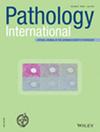Molecular pathology of small cell lung cancer: Overview from studies on neuroendocrine differentiation regulated by ASCL1 and Notch signaling
IF 3.4
4区 医学
Q2 PATHOLOGY
引用次数: 0
Abstract
Pulmonary neuroendocrine (NE) cells are rare airway epithelial cells. The balance between Achaete‐scute complex homolog 1 (ASCL1) and hairy and enhancer of split 1, one of the target molecules of the Notch signaling pathway, is crucial for NE differentiation. Small cell lung cancer (SCLC) is a highly aggressive lung tumor, characterized by rapid cell proliferation, a high metastatic potential, and the acquisition of resistance to treatment. The subtypes of SCLC are defined by the expression status of NE cell‐lineage transcription factors, such as ASCL1, which roles are supported by SRY‐box 2, insulinoma‐associated protein 1, NK2 homeobox 1, and wingless‐related integration site signaling. This network reinforces NE differentiation and may induce the characteristic morphology and chemosensitivity of SCLC. Notch signaling mediates cell‐fate decisions, resulting in an NE to non‐NE fate switch. The suppression of NE differentiation may change the histological type of SCLC to a non‐SCLC morphology. In SCLC with NE differentiation, Notch signaling is typically inactive and genetically or epigenetically regulated. However, Notch signaling may be activated after chemotherapy, and, in concert with Yes‐associated protein signaling and RE1‐silencing transcription factor, suppresses NE differentiation, producing intratumor heterogeneity and chemoresistance. Accumulated information on the molecular mechanisms of SCLC will contribute to further advances in the control of this recalcitrant cancer.小细胞肺癌的分子病理学:受 ASCL1 和 Notch 信号调控的神经内分泌分化研究综述
肺神经内分泌(NE)细胞是罕见的气道上皮细胞。Achaete-scute复合体同源物1(ASCL1)与Notch信号通路的靶分子之一毛发和分裂增强子1之间的平衡对NE的分化至关重要。小细胞肺癌(SCLC)是一种侵袭性很强的肺部肿瘤,其特点是细胞增殖快、转移潜力大、耐药性强。SCLC的亚型是根据NE细胞系转录因子(如ASCL1)的表达状态确定的,SRY-box 2、胰岛素瘤相关蛋白1、NK2 homeobox 1和无翼鸟相关整合位点信号支持这些转录因子的作用。这一网络加强了NE的分化,并可能诱发SCLC的特征性形态和化学敏感性。Notch信号介导细胞命运决定,导致NE向非NE命运转换。抑制NE分化可能会使SCLC的组织学类型变为非SCLC形态。在NE分化的SCLC中,Notch信号通常不活跃,并受遗传或表观遗传调控。然而,化疗后Notch信号可能被激活,并与Yes相关蛋白信号和RE1沉默转录因子共同抑制NE分化,从而产生瘤内异质性和化疗耐药性。有关 SCLC 分子机制的信息积累将有助于进一步推动对这种顽固癌症的控制。
本文章由计算机程序翻译,如有差异,请以英文原文为准。
求助全文
约1分钟内获得全文
求助全文
来源期刊

Pathology International
医学-病理学
CiteScore
4.50
自引率
4.50%
发文量
102
审稿时长
12 months
期刊介绍:
Pathology International is the official English journal of the Japanese Society of Pathology, publishing articles of excellence in human and experimental pathology. The Journal focuses on the morphological study of the disease process and/or mechanisms. For human pathology, morphological investigation receives priority but manuscripts describing the result of any ancillary methods (cellular, chemical, immunological and molecular biological) that complement the morphology are accepted. Manuscript on experimental pathology that approach pathologenesis or mechanisms of disease processes are expected to report on the data obtained from models using cellular, biochemical, molecular biological, animal, immunological or other methods in conjunction with morphology. Manuscripts that report data on laboratory medicine (clinical pathology) without significant morphological contribution are not accepted.
 求助内容:
求助内容: 应助结果提醒方式:
应助结果提醒方式:


